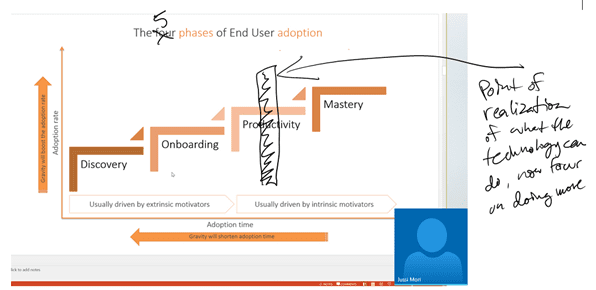The Technology threshold of End User Adoption
Chalk this one up to stream-of-consciousness writing:
A couple weeks back I was discussing gamification and end user adoption with my fellow SharePoint MVP Jussi Mori (@JussiMori), founding partner at Peaches Industries Finland, with Jussi walking me through his company’s latest end user engagement method, called Gravity. For those less familiar with the concept of gamification, the goal is to use data and social tools to encourage desired end user behavior, often using methods such as recognition, rewards, and even games to help people better communicate and collaborate. A fundamental belief behind gamification is that having more people actively engaged will improve collaboration for everyone, and more quickly provide ROI for the organization.
A quick overview of Gravity from the Peaches website:
Gravity is an actionable End-User Engagement engine designed for Information portals built on SharePoint 2013 or Office 365 SharePoint online. It uses methods of games (Gamification) to help users get engaged in their work and get connected with each other and drive value for the Organization through that. The key is content and context. The Gamification engine works in all of the four adoption phases (Discovery, On-boarding, Productivity and Mastery) and takes the most out of the End Users activities and boosts productivity.
As Jussi walked me through the Gravity model that was designed for use with SharePoint 2013 and SharePoint Online within Office365, outlining the purpose and actions taken within each of the four phases (Discovery, Onboarding, Productivity, and Mastery), one thought kept sticking out in my mind: For most end users who have reached the productivity phase, that there is a distinct point in time when the technology becomes “understood” and productivity increases. To help illustrate what I mean by this, consider something most people have experienced: learning to ride a bicycle. At some point in the learning process, riding become second nature – and the bicycle becomes forgotten. It becomes simply a tool with which you can get from point to point, and your thoughts no longer dwell on how, but where you can go.
So as Jussi was explaining the model and describing the Productivity phase, in my mind there were two steps within the phase – being productive with a limited understanding of what the platform can do (I can ride my bike and get from point to point), and an increased level of productivity with a full understanding of the platform (I forget about my fears of riding, and simply concentrate on where I want to go). In my mind, there is a threshold within the Productivity phase – which I have seen with the SharePoint education cycle: people can become very productive with a limited knowledge of SharePoint’s capabilities. But once that knowledge and proficiency increases, so does their potential for productivity.
Now, this increased productivity is not to be confused with the Mastery phase of the Gravity model – which, in my mind, has more to do with the business activities, and not with mastery of the technology (in this case SharePoint). Productivity is about improving on and automating existing activities and workloads, while Mastery is about creating entirely new workloads based on a new perspective of what is possible.
Wow, this all sounds much more philosophical than I had intended. But such is the stream-of-consciousness writing method. I had an idea stuck in my head, and now its out. Now I can get back to other things….





